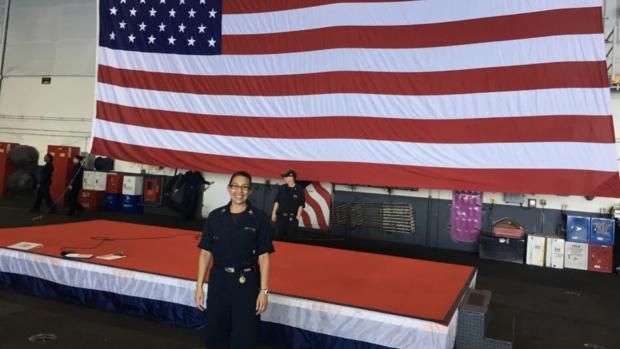From nuclear-powered warships to building new biomedical devices

Jessica Espinoza served in the U.S. Navy for seven years before coming to NYU Tandon.
Jessica Espinoza has had an unconventional journey to NYU Tandon. From teaching kids in the Bay Area to working on a 116 thousand ton ship, she’s now a graduate student with the Department of Biomedical Engineering. Getting there was a true odyssey.
Espinoza entered UC Irvine thinking about being a doctor. For one of her classes, she was building a basic EKG machine that sparked her love of engineering. “That's when it switched for me, where I was so amazed to just take these wire resistors and make them communicate with each other. And then you attached them to yourself, cross your fingers and hope it worked. It was a great feeling.”
She spent a great deal of time working with local high schoolers and middle schoolers as part of an organization called MESA: Mathematics, Engineering and Science Achievement. There she taught the basics of engineering through applied lessons — building bionic arms, trebuchets, and other tools to compete with other schools. When it came time to graduate though, she had trouble finding the right fit in the job market. Her passion for education wasn’t as well suited to mechanical engineering firms, so she looked elsewhere — the U.S. Navy.
Specifically, Espinoza was aiming for the nuclear mechanics program. The U.S. Navy has two types of nuclear-powered ships — aircraft carriers and submarines — so the engineers who worked on these had to be on the top of their game. Just to get into the program, recruits have to score in the top 95 percent of test takers to be admitted. Espinoza earned her spot, and spent the next year in classes — first basic engineering, then the education necessarily to work on the warships themselves. It was a lesson both in the skills she would need for working in the Navy, but also a lesson in the kind of rigor and procedures necessary for military life.
Finally, after graduating from Navy classes, Espinoza was chosen to be an instructor for the classes she had just finished. She was serving as an intermediate — helping connect the new students to personnel who were returning from ship duty, while teaching the classes herself.
After two years as an instructor, she was chosen to serve on the USS Truman, a Nimitz-class aircraft carrier, working with the reactor. Working out at sea was a definite change: “There is very little to distract you out there,” Espinoza said. “I slept little, and studied a lot more. I had a lot to learn.” Unfortunately, her tour was cut short when she tore her ACL in two locations. It had been the second time she had sustained the same injury, so the Navy had to pull her from her duties to review her case. She was sent back to land in the meantime.
While it was being decided whether the Navy could risk putting her back on a ship, Espinoza worked on reactors at shore. She continued some teaching duties, mentoring personnel who would be going out to sea soon. But her mind started to wander to what would come after the Navy. She started taking GRE practice exams, with the hope of entering the medical profession once again. Her next stop would be NYU Tandon.
“That was a whole year process between getting out and going to school and figuring out where I was going. To figure out which doors are going to be opening and then which ones I wanted to step through”
Talking to doctors and other engineers, Espinoza was attracted to the New York City area. And Tandon offered a particularly good fit, where people from diverse backgrounds and life experiences could excel. She was looking to combine her two backgrounds: biomedical engineering and nuclear energy. Technology like x-rays and MRI machines already combined them in some capacity. But she also wanted to come up with her own devices — something that would help people like her with injuries that might push them out of work.
Her injuries caused nerve pain that is typically treated with medication and physical therapy. In the Navy, medication like that wouldn't be compatible with active-duty service. So Espinoza has become working on a specialized brace — lighter weight and leaner than typical braces — that might have helped her in her Navy career. She’s been working with Smita Rao, professor in the Department of Physical Therapy and Department of Orthopedic Surgery at Steinhardt as well as an affiliated faculty member of the Department of Biomedical Engineering at Tandon.
And while Espinoza is new to Graduate school, in a year that has been anything but normal, the experience has been a huge positive.
“I was nervous about coming. I had been out of school for 10 years, I was older than most of the other students. But I never felt like an outsider. Everybody's talking to each other. Everybody shares ideas, professors are always engaging us and looking for researchers. It's just really exciting to talk about these things that interest you.”





